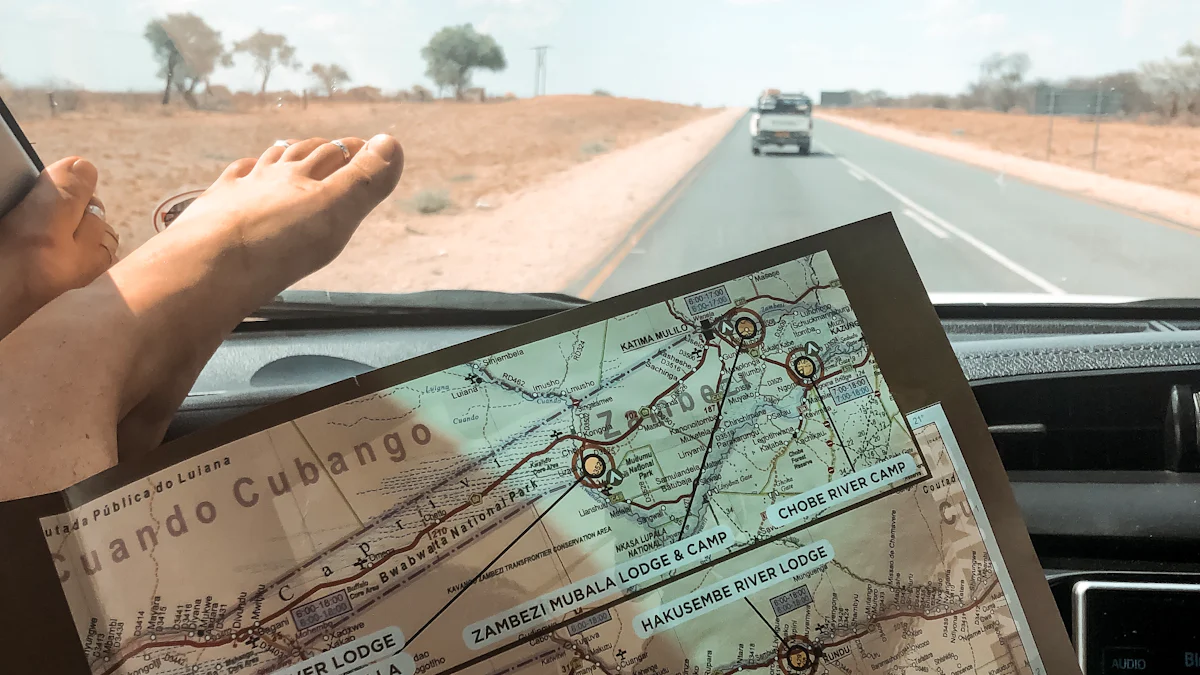
Imagine driving through a paradise where snow-capped mountains, vibrant meadows, and serene forests unfold before your eyes. The Li Xiaolu self-driving route offers you this magical escape. As you journey along this scenic path connecting Li County and Xiaojin County, nature’s beauty surrounds you. Red leaves, cascading waterfalls, and Tibetan villages create a mesmerizing backdrop. This route isn’t just a drive; it’s a chance to find peace, breathe fresh mountain air, and immerse yourself in the wonders of Sichuan. Ready to embark on this unforgettable adventure? Let’s hit the road with your ultimate Self-driving guide for the WESTERN SICHUAN Li Xiao Lu Loop Road!
Key Takeaways
- Start your journey in Chengdu and embrace the transition from urban life to the serene countryside as you drive towards Ya’an.
- Capture stunning photographs in Xinduqiao, known as a photographer’s paradise, with its golden meadows and snow-capped peaks.
- Experience Tibetan culture by visiting the Tagong Monastery and exploring the unique architecture of Danba’s Tibetan watchtowers.
- Plan your trip for autumn to enjoy vibrant foliage and clear skies, making every view along the route spectacular.
- Ensure a smooth journey by using a 4WD vehicle, checking road conditions, and packing essential emergency supplies.
- Respect local customs by learning basic Tibetan phrases and adhering to cultural etiquette when visiting sacred sites.
- Pack smartly with layered clothing, offline maps, and snacks to enhance your comfort and enjoyment during the drive.
Overview of the Li Xiaolu Self-Driving Route

Embarking on the Li Xiaolu self-driving route is like stepping into a living postcard. This journey takes you through some of Sichuan’s most breathtaking landscapes, blending natural beauty with cultural richness. Whether you’re chasing snow-capped peaks or exploring vibrant Tibetan villages, every stop along the way offers something unforgettable.
Key Destinations Along the Route
Chengdu to Ya’an: Gateway to the journey with urban comforts and scenic transitions
Your adventure begins in Chengdu, a city known for its lively atmosphere and delicious cuisine. As you drive toward Ya’an, the scenery shifts from bustling urban life to tranquil countryside. Ya’an, often called the “Rain City,” charms visitors with its tea culture and lush surroundings. This stretch sets the tone for the incredible sights ahead.
Kangding and Xinduqiao: Snow-capped mountains, Tibetan culture, and photography hotspots
Kangding welcomes you with its iconic Paoma Mountain and rich Tibetan heritage. The crisp mountain air and serene environment make it a perfect place to acclimate. From Kangding, head to Xinduqiao, a paradise for photographers. Here, golden meadows, winding rivers, and distant snowy peaks create picture-perfect moments at every turn.
Tagong Grassland and Danba: Vast meadows, Tibetan monasteries, and traditional villages
The Tagong Grassland stretches endlessly, dotted with grazing yaks and prayer flags fluttering in the wind. Visit the Tagong Monastery to experience Tibetan spirituality. Continue to Danba, home to unique Tibetan watchtowers and villages. Known as one of China’s most beautiful rural areas, Danba offers a glimpse into traditional Tibetan life.
Siguniang Mountain Town and Xiaojin County: Stunning peaks, hiking trails, and serene landscapes
Siguniang Mountain, often called the “Queen of Sichuan’s Peaks,” captivates with its majestic beauty. The surrounding area offers hiking trails for all skill levels, leading to pristine lakes and forests. As you drive through Xiaojin County, the peaceful landscapes and charming villages invite you to slow down and soak in the tranquility.
Li County: Vibrant autumn foliage and the endpoint of the route
Li County marks the final leg of your journey. In autumn, the fiery red and golden leaves transform the area into a photographer’s dream. The combination of colorful forests and snow-dusted mountains creates a scene straight out of a fairytale. It’s the perfect place to reflect on your adventure before heading back to Chengdu.
Best Time to Visit
Autumn (September to November): Ideal for colorful foliage and clear skies
Autumn is the most popular season for this route. The vibrant foliage, paired with clear skies, makes every view spectacular. Photographers flock here to capture the fiery reds and oranges of the trees against the snowy peaks.
Spring and Summer: Blooming flowers and lush greenery
Spring and summer bring a different kind of charm. Wildflowers blanket the meadows, and the lush greenery creates a refreshing atmosphere. These seasons are perfect for those who love vibrant landscapes and mild weather.
Avoiding the rainy season: Tips for safe travel during potential landslide risks
The rainy season can pose challenges, with increased risks of landslides and slippery roads. If you plan to travel during this time, check road conditions in advance. Drive cautiously and carry essentials like a spare tire and emergency supplies to ensure a safe journey.
“The Li Xiaolu route isn’t just a drive; it’s a journey through nature’s masterpiece. From the fiery autumn leaves to the serene summer meadows, every season offers a unique experience.”
Day-by-Day Itinerary for Your Li Xiaolu Journey

Planning your journey along the Li Xiaolu route? This day-by-day itinerary ensures you make the most of every moment. From cultural experiences to breathtaking landscapes, here’s how to structure your adventure.
Day 1: Starting Point and Initial Highlights
Begin in Chengdu, drive to Ya’an, and explore the tea culture.
Start your journey in Chengdu, a city that blends modern energy with rich traditions. Before hitting the road, grab a hearty breakfast of local delicacies like hotpot or dumplings. As you drive toward Ya’an, the scenery transforms from urban sprawl to lush greenery. Known as the “Rain City,” Ya’an invites you to explore its famous tea plantations. Take a break to learn about the art of tea-making and enjoy a cup of freshly brewed tea.
Continue to Kangding, visiting the famous Paoma Mountain.
From Ya’an, continue your drive to Kangding, where the majestic Paoma Mountain awaits. The mountain, steeped in Tibetan folklore, offers panoramic views and a chance to stretch your legs. Walk along the trails, breathe in the crisp mountain air, and immerse yourself in the serene surroundings. Kangding also serves as a gateway to Tibetan culture, making it an ideal spot to acclimate to the altitude.
Stay overnight in Kangding for acclimatization.
End your first day by settling into a cozy guesthouse or hotel in Kangding. Rest well to prepare for the higher altitudes ahead. Enjoy a warm meal featuring local Tibetan flavors, such as yak meat or butter tea, to complete your day.
Day 2: Exploring the Heart of Li Xiaolu
Drive to Xinduqiao for photography and Tibetan culture.
Begin your second day with a scenic drive to Xinduqiao, often called a “photographer’s paradise.” The golden meadows, winding rivers, and distant snow-capped peaks create a dreamlike setting. Stop frequently to capture the beauty of this area. The Tibetan culture here is vibrant, with prayer flags and traditional homes adding to the charm.
Visit Tagong Grassland and the Tagong Monastery.
Next, head to the expansive Tagong Grassland. The sight of grazing yaks and fluttering prayer flags will leave you in awe. Visit the Tagong Monastery, a spiritual hub for Tibetan Buddhists. The monastery’s intricate architecture and peaceful ambiance provide a glimpse into Tibetan spirituality.
Stay overnight in Danba, known for its Tibetan watchtowers.
Conclude your day in Danba, a village famous for its unique Tibetan watchtowers and traditional homes. These ancient structures, surrounded by lush landscapes, tell stories of the region’s history. Spend the night in a local Tibetan-style guesthouse to experience authentic hospitality.
Day 3: Wrapping Up the Journey
Explore Siguniang Mountain Town and enjoy hiking trails.
On your final day, drive to Siguniang Mountain Town, home to the “Queen of Sichuan’s Peaks.” Choose a hiking trail that suits your fitness level and explore pristine lakes, dense forests, and stunning mountain views. The natural beauty here is unmatched, offering a perfect blend of adventure and tranquility.
Drive through Xiaojin County and Li County, enjoying the autumn scenery.
Continue your journey through Xiaojin County and Li County. In autumn, the fiery red and golden foliage creates a magical atmosphere. Stop at viewpoints to soak in the scenery and take memorable photos. The peaceful villages along the way add a touch of charm to your drive.
Return to Chengdu or extend your trip to nearby attractions.
As your journey comes to an end, return to Chengdu with a heart full of memories. If time permits, consider extending your trip to explore nearby attractions like Mount Emei or Jiuzhaigou Valley. These destinations offer even more opportunities to connect with nature and culture.
“Every mile of the Li Xiaolu route tells a story. From the bustling streets of Chengdu to the tranquil peaks of Siguniang, this journey is a celebration of Sichuan’s beauty and heritage.”
Essential Travel Tips for a Smooth Journey
Vehicle Requirements and Road Conditions
Use a 4WD vehicle for better control on mountain roads.
Driving through the Li Xiaolu route requires a reliable vehicle. A 4WD vehicle handles mountain roads better, especially on steep or uneven terrain. It gives you more control and ensures a smoother ride. Before starting your journey, inspect your vehicle thoroughly. Check the brakes, tires, and engine to avoid unexpected issues.
Check road conditions in advance and carry a spare tire.
Mountain roads can be unpredictable. Some sections may have temporary closures or rough patches. Always check road conditions before heading out. Carry a spare tire and know how to change it. This simple preparation can save you from delays and keep your trip stress-free.
Weather and Safety Considerations
Pack for varying weather, including warm layers and rain gear.
The weather along the route changes quickly. Mornings can be chilly, afternoons warm, and evenings cold. Pack warm layers, a waterproof jacket, and sturdy shoes. These essentials keep you comfortable and ready for any weather surprises.
Carry emergency contacts and a first aid kit.
Safety should always come first. Keep a list of emergency contacts, including local authorities and roadside assistance numbers. A well-stocked first aid kit is a must. Include bandages, antiseptic wipes, pain relievers, and altitude sickness remedies. These items ensure you’re prepared for minor injuries or health concerns.
Cultural Etiquette and Local Customs
Respect Tibetan traditions, such as not touching religious artifacts.
The Li Xiaolu route passes through Tibetan regions rich in culture and spirituality. Show respect by following local customs. Avoid touching religious artifacts or entering sacred spaces without permission. When visiting monasteries, dress modestly and maintain a quiet demeanor.
Learn basic phrases in the local language to interact with locals.
A few words in the local language go a long way. Simple phrases like “hello” (tashi delek) or “thank you” (thuk-je-che) create a friendly connection. Locals appreciate your effort to communicate in their language. It enhances your experience and fosters meaningful interactions.
“Preparation is key to a smooth journey. From choosing the right vehicle to respecting local customs, these tips ensure you enjoy every moment of your Li Xiaolu adventure.”
Checklist of Must-Have Items for the Trip
Travel Essentials
Offline maps, GPS devices, and a reliable navigation app
Navigating the Li Xiaolu route requires preparation. Cell signals can be unreliable in remote areas, so download offline maps before your trip. Equip yourself with a GPS device or a dependable navigation app to stay on track. These tools ensure you never lose your way, even in areas without network coverage.
Layered clothing, sunglasses, and sunscreen for high-altitude conditions
The weather along the route can change quickly. Pack layered clothing to adapt to varying temperatures. Include a warm down jacket, waterproof snow boots, and accessories like scarves, gloves, and hats to stay comfortable. Don’t forget sunglasses and sunscreen to protect yourself from the strong UV rays at high altitudes. A portable umbrella can also come in handy for unexpected rain showers.
Emergency Supplies
A first aid kit, vehicle repair tools, and a portable oxygen canister
Safety should always be a priority. Carry a well-stocked first aid kit with essentials like bandages, antiseptic wipes, and altitude sickness remedies. Bring vehicle repair tools, including a spare tire, to handle any roadside emergencies. At elevations above 3,000 meters, a portable oxygen canister becomes essential to prevent altitude sickness and keep you feeling your best.
Power banks and a satellite phone for remote areas
Stay connected by packing power banks and chargers to keep your devices charged throughout the journey. In areas with no cell signal, a satellite phone ensures you can call for help if needed. These items provide peace of mind and keep communication smooth, even in the most remote locations.
Comfort and Convenience Items
Snacks, water bottles, and entertainment for long drives
Long drives can be tiring, so pack plenty of snacks and water bottles to stay energized and hydrated. A thermos cup is perfect for keeping hot water or tea ready whenever you need it. Bring entertainment options like music playlists, audiobooks, or travel games to make the journey more enjoyable.
Travel permits, ID cards, and cash for rural areas
Some parts of the route may require travel permits, so check the requirements in advance. Keep your ID cards handy for identification purposes. In rural areas, cash is often preferred over digital payments, so carry enough to cover meals, accommodations, and other expenses. Being prepared ensures a hassle-free experience.
“Packing smartly transforms your trip from stressful to seamless. With the right essentials, you’ll be ready to embrace every moment of your Li Xiaolu adventure.”
The Li Xiaolu self-driving route offers you a journey filled with breathtaking landscapes, rich Tibetan culture, and unforgettable adventures. From the golden meadows of Xinduqiao to the serene peaks of Siguniang Mountain, every moment on this route feels like stepping into a dream. Embrace the freedom of self-driving and create memories that will last a lifetime. Let this Self-driving guide for the WESTERN SICHUAN Li Xiao Lu Loop Road be your trusted companion as you plan your adventure. Pack your bags, start your engine, and let the road lead you to magic!
FAQ
How do I start my self-driving journey on the Li Xiaolu route?
To begin your adventure, start in Chengdu. Follow the Chengdu-Guanzhou Expressway, then transition to the Duwen Expressway. Exit at Wenchuan and continue along National Highway 317 to reach the Bipenggou scenic spot. The entire drive spans about 190 kilometers and takes approximately 3-4 hours. This route offers a smooth start to your journey with stunning views along the way.
What’s the best time to travel the Li Xiaolu route?
The ideal time to explore this route is during autumn, from September to November. The vibrant foliage and clear skies create a breathtaking experience. Spring and summer also offer lush greenery and blooming flowers, perfect for nature lovers. Avoid the rainy season to ensure safer travel and better road conditions.
How can I prepare for high-altitude conditions?
Altitude sickness can affect travelers unfamiliar with high elevations. To prepare, avoid strenuous activities upon arrival, stay hydrated, and dress warmly. Carry a portable oxygen canister for emergencies. These precautions help you adjust comfortably to the higher altitudes along the route.
Are there any must-visit spots along the route?
Absolutely! Don’t miss these highlights:
- Tagong Grassland: Expansive meadows with grazing yaks and Tibetan monasteries.
- Danba Tibetan Villages: Unique watchtowers and traditional Tibetan homes.
- Siguniang Mountain: Stunning peaks and serene hiking trails.
- Li County: Vibrant autumn foliage and picturesque landscapes.
Each destination offers a unique blend of natural beauty and cultural richness.
What type of vehicle should I use for this trip?
A 4WD vehicle is highly recommended. It provides better control on mountain roads and handles uneven terrain effectively. Before starting your journey, inspect your vehicle thoroughly. Check the brakes, tires, and engine to ensure a smooth and safe drive.
How do I navigate areas with limited cell signal?
In remote regions, cell signals can be unreliable. Download offline maps and use a GPS device or a reliable navigation app. Carrying a satellite phone ensures you stay connected in case of emergencies. These tools keep you on track and provide peace of mind.
What should I pack for the trip?
Here’s a quick checklist:
- Clothing: Layered outfits, warm jackets, and waterproof gear.
- Essentials: Sunglasses, sunscreen, and a first aid kit.
- Emergency Supplies: Spare tire, vehicle repair tools, and power banks.
- Comfort Items: Snacks, water bottles, and entertainment for long drives.
Packing smartly ensures a comfortable and hassle-free journey.
How can I respect local Tibetan culture?
Respecting local customs enriches your experience. Avoid touching religious artifacts and seek permission before entering sacred spaces. Dress modestly when visiting monasteries and maintain a quiet demeanor. Learning basic phrases like “hello” (tashi delek) or “thank you” (thuk-je-che) fosters positive interactions with locals.
Are there any safety tips for driving on mountain roads?
Mountain roads can be unpredictable. Drive cautiously, especially in areas prone to landslides. Check road conditions in advance and carry a spare tire. Keep emergency contacts handy and ensure your vehicle is in top condition. These steps help you navigate safely through the scenic yet challenging terrain.
Can I complete the Li Xiaolu route in two days?
Yes, a two-day itinerary works well for this journey. Day one covers Chengdu to Kangding, with stops at Ya’an and Paoma Mountain. Day two explores Xinduqiao, Tagong Grassland, and Danba before wrapping up in Li County. This plan ensures you experience the route’s highlights without feeling rushed.
“The Li Xiaolu route promises an unforgettable adventure. With proper planning and preparation, you’ll enjoy every moment of this scenic journey.”